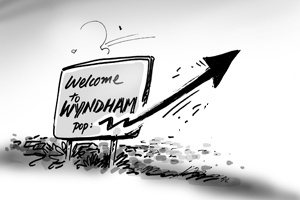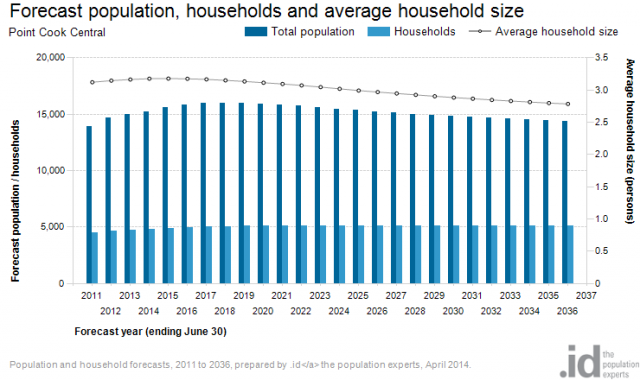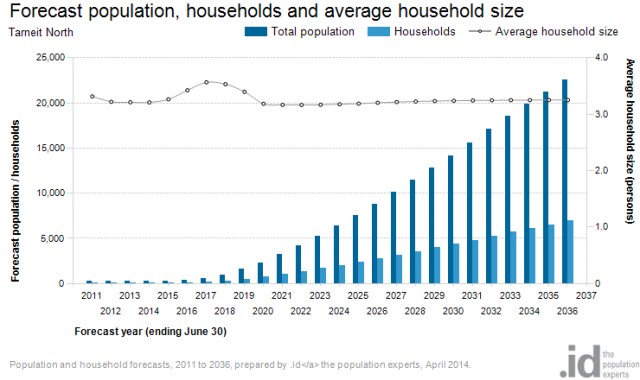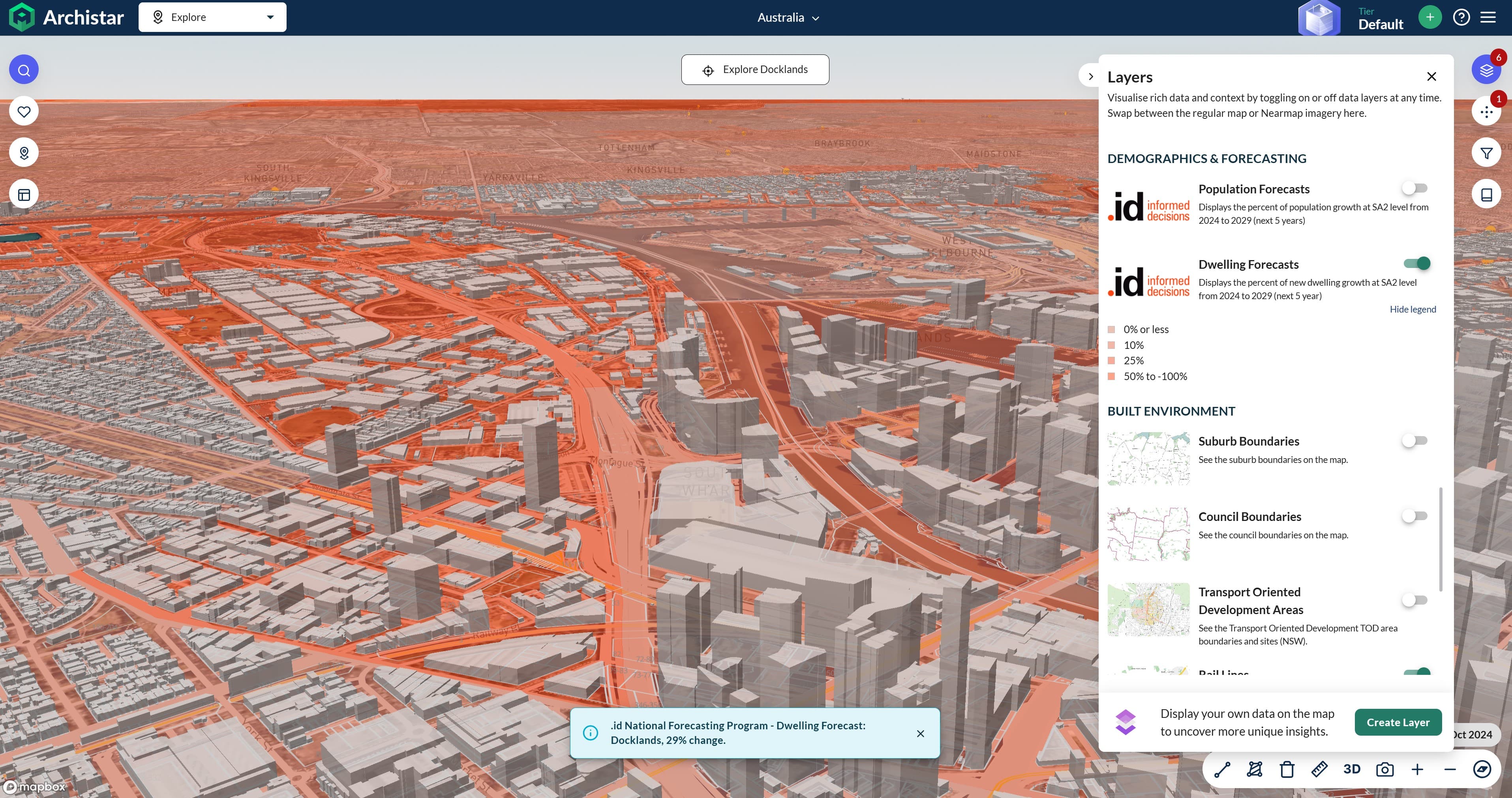assumptions-vs-predictions-the-science-of-forecastingWyndham City Council is a rapidly growing suburban area located in Melbourne’s outer south west. Growth has been so rapid, that in recent years it has often recorded the fastest annual rate of population growth in the country.
In 1991, the population was 63,420, but it surpassed 100,000 in 2004 and by 2011 stood at 166,700. Annual growth rates upwards of 7% occurred each year between 2007 and 2012, but dropped slightly to a still rapid 6.0% in 2013.
While this rapid growth creates obvious challenges for service planning and infrastructure delivery, it does mask a great deal of diversity within the municipality itself. Let’s take a closer look at Wyndham.

Forecast.id updated for Wyndham
.id has recently updated the population forecast for Wyndham which incorporates the latest available data from the 2011 Census and rebased final ERP data. Wyndham is assumed to continue its growth trajectory for some time, due to the large supply of existing and proposed residential land, as well as the continued demand for affordable family housing.
The population is expected to surpass 200,000 by 2015, and then 300,000 in the late 2020s, before reaching 384,280 at 2036 (the end of the forecast period). In a housing market sense, Wyndham has historically provided home owning opportunities for new and prospective families from other parts of Melbourne’s west, but increasingly from the inner north and south-east. A map depicting the major net migration flows in and out of Wyndham can be found here. It confirms that Wyndham records high levels of in-migration from neighbouring Hobsons Bay and Brimbank in particular, but historical Census data shows that this trend has been occurring for some time.
The importance of geography
One of the great advantages of .id’s forecasts is the availability of data for small areas. There are 35 small areas in Wyndham, loosely based on locality boundaries. Note that they are not SA2s as defined by the ABS – not only can SA2s overlap LGA boundaries, but we prefer to work with councils to find a geography that suits their needs. For instance, the gazetted locality of Hoppers Crossing is quite large, so for the forecasting purposes it has been split into six small areas. The forecast.id website displays and describes the boundaries of each small area.
The small areas in Wyndham with the greatest number of assumed new dwellings between 2011 and 2036 are Tarneit North (7,782), Point Cook South (7,282), Manor Lakes West (6,235) and Racecourse (5,607). It is no surprise that these areas have a significant amount of residential supply which is either currently under development, or is about to undergo a transformation from grassland to suburb. Point Cook South illustrates this well – in 2014 there are seven estates which are in various stages of development, with a further five future sites identified for future growth.
On the other side of the coin, there are parts of Wyndham which have stable or even declining populations. These tend to be in the more established parts of the City such as Werribee and Hoppers Crossing, particularly those which underwent their major growth phase in the 1980s and 1990s. The young children of the families who moved there are now young adults, and are starting to move out of home to create their own households elsewhere (probably in Point Cook!), leaving behind a smaller house of Mum and/or Dad. Examples include most of Hoppers Crossing (Kingston, Woodville, Bellbridge, Mossfiel and Cambridge) as well as parts of Werribee (Riverdene).
With limited scope for new residential development in some areas, the result is population decline. Over time, these areas are likely to regenerate as existing households mature further and mortality becomes more prevalent. This then paves the way for a new but incremental phase of growth. The challenge for service planning in these areas should not be underestimated, as the facilities demanded by young households are very different to mature/elderly households. The trick is to plan for robustness so that spaces can be adapted for different age structures and household types.
How Point Cook is different to Tarneit
Both of these suburbs have recorded substantial growth in recent years as Wyndham’s urban frontier extends north west (Tarneit) and south (Point Cook). Again, these are large and diverse suburbs so they have been split into smaller areas for forecasting purposes. Each has different planning and service requirements and the forecast population and age structure illustrates this point.
Point Cook Central has been a favoured location for young households for some time now, but in 2014 most of the existing residential supply has been exhausted and the relatively small lot sizes and young age of the dwellings does not favour much in the way of further subdivision. It is assumed that the residential supply will be exhausted in the late 2010s, and after this time the population will stabilise before declining. The 2011 population will continue to grow steadily in the short term (see graph below), peaking at around 16,000 in the late 2010s, and then declining as the young adults of that time start to move out of the family home. The result is a population of 14,350 at 2036 – slightly less than the 2013 population – but one with a much older age profile and household structure.

This contrasts sharply with Tarneit North, a not so distant future residential area located north of Leakes Road. From a 201 population of just 230 persons, with the assumed large number of dwellings to be constructed from the late 2010s it will reach a population of more than 3,200 by 2021 and over 22,000 by 2036 (see graph below). Of course, these figures are based on assumptions around future dwelling growth (not predictions!), but given the evidence base established in other recently developed parts of Wyndham, coupled with the growth impetus created by continued high net overseas migration into Melbourne, it would be a brave forecaster not to assume a similar pattern of growth.

Furthermore, it is assumed that a significant proportion of this growth will be driven by in-migration of young families, resulting in a young age profile with particular service needs. But if one thing is relatively certain about the future it is that suburbs will continue to evolve, and eventually Tarneit North will reach a point where its age profile start to mature, resulting in a different set of services demand by the population.
The availability of small area forecasts provides a significant amount of data for our local government clients to use in their forward planning. Wyndham City Council is one of the larger forecasts we undertake here at .id – not just in terms of the assumed growth, but the number of small areas. Sometimes it’s not just the scale of growth, but how and why a population changes that is just as important. The .id approach to small area forecasting provides the evidence base for councils to understand how their communities are changing and to undertake proactive rather than reactive planning.
The latest population and housing forecast for Wyndham can be found here.
For more population forecasts of Australia, visit our demographic resource centre. If you would like learn more about population forecasting, visit our website or contact us via email. You may also wish to sign up to our newsletter to receive the latest population and demographic insights of Australia.














